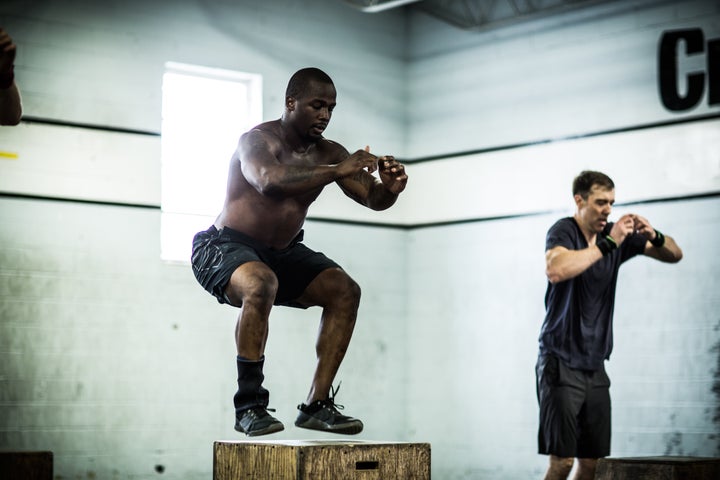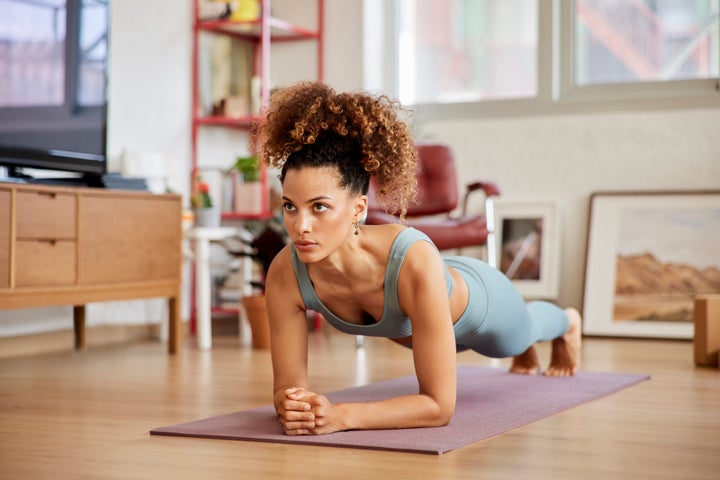Some of the most popular workout moves aren’t just ineffective, they can be dangerous.
Few things are more frustrating than injuring yourself during a workout — a time that is intended to be a benefit for your physical and mental health. But, sadly, it happens. And some exercises lead to injury more than others.
When it comes to safety concerns, personal trainers have workout moves they avoid or don’t do with clients for this exact reason — along with the fact that some movements are ineffective.
Below, fitness professionals share the exercise they don’t do in their workouts, along with some alternatives to try instead:
American Kettlebell Swing
Jay Rose, the co-founder of Phase SiX, an online fitness training program, said one movement he advises people to avoid is the American kettlebell swing, which is a movement where you swing a kettlebell from between your legs to above your head while keeping your arms straight.
“You used to see it a lot a few years ago … it’s kind of calmed down a little bit, but it’s still being used out there,” he said.
According to Rose, this movement can lead to a number of issues — the first being an increased risk of injury. “The overhead position can put excessive strain on the shoulder, lower back and neck, especially if the lifter has poor shoulder mobility or lack of necessary strength to control the kettlebell in the overhead position,” he said.
“It also compromises form as the kettlebell reaches the overhead position. Maintaining proper form becomes challenging and the lifter might arch their back or bend their elbows to compensate for the additional range of motion, which can lead to poor technique and potential injuries,” Rose added.
Instead of this, Rose said a traditional Russian kettlebell swing, where you swing the kettlebell from between your legs to roughly shoulder height, is a better movement to try.
“There [are] several benefits that the Russian kettle swing offers … it’s safer for the shoulders, lower back and neck,” he said.
With the American kettlebell swing, you can lose track of the kettlebell once your arms are extended and it’s over your head (because you aren’t looking up at the kettlebell), which can result in injury. But, with the Russian swing, you’re stopping at eye level.
This “reduces strain on the shoulder, joints and spine,” Rose said. The shorter range of motion also helps the lifter maintain proper technique throughout the exercise, he added.

Smith Machine Squat
“So, specifically something I don’t do and it’s more so the equipment that I don’t use for this particular movement … is a Smith machine squat,” said Giulia Cammarano, a coach at Kali Strength, a women’s-only gym in Denver. (A Smith machine is a type of fitness equipment.)
For these kinds of squats, the barbell is attached to a frame and stabilized within a rack that moves up and down. “It’s not just a free barbell,” explained Cammarano.
While there is nothing wrong with doing squats with a Smith machine generally, the exercise just doesn’t align with Cammarano’s training philosophy, which focuses on compound and functional movements.
Compound exercises are “movements that use multiple muscle groups and joints simultaneously,” she said. “Like a barbell squat, for example, and is a really key component to total body strength development.”
While squats are often thought to be an only-lower-body exercise, Cammarano said they actually work the entire body when performed correctly — and without the use of a Smith machine.
“Squatting on the Smith machine just removes that added [full body] benefit since it follows a direct path and you’re supported by the stability of a machine … it just completely removes the need to maintain, balance and stabilize the body with other muscle groups,” she said. Particularly, it erases the need to engage the core.
Instead of a Smith machine squat, Cammarano said she opts for a free-weight dumbbell goblet squat or a barbell back squat.
“These are essentially the same movement, it’s a squat, it’s just using different equipment and not being as supported,” she said. “And they’re compound movements but all you’re supported by is the stability of your body and the activation of the smaller muscles in the core to support the movement.” This makes these exercises better for training effectiveness, she said.
Barbell Glute Bridge
“I definitely believe that the barbell glute bridge is an overhyped exercise when it comes down to glute hypertrophy,” aka muscle building in the glutes, said Andrew Gonzalez, a trainer at Chelsea Piers in Brooklyn.
“While staying in the realm of hip hinging, I believe barbell Romanian deadlifts and Good Mornings … using the safety squat bar are better alternatives for glute hypertrophy because they provide a better stretch-to-shorten stimulus,” Gonzalez said.
Beyond this, he said the Bulgarian split squat with a little bit of front-foot elevation is his go-to movement for glute work. “These exercises provide a better environment to give fuller ranges of motion on the eccentric part of the movement rather than the concentric, which is known to be a better driver for hypertrophy all around,” he said.
Weighted Plank
For Jessica Aronoff, the head trainer at the ness, a dance-based fitness studio in New York, the movement she avoids is a weighted plank. (A plank is a core strength exercise where you hold yourself in a push-up position and engage your abdominals.)
“Loading a plank with weight can often lead to compromised form [like] a sway in the low back, which means you’ve released [your] core engagement, and/or unnecessary tension in the traps and neck as we focus on simply resisting against the weight,” she said.
Instead of using weight to level up your plank, Aronoff said there are other ways to do so. “Plank is a wonderful bodyweight exercise because it encourages you to engage your core using stability,” Aronoff said. “A great way to challenge your plank is to challenge your stability.”
Here are some ways to do that: You can try a three-point plank where you alternate lifting a leg or arm without rocking, try a plank march or plank on an unstable surface like a trampoline or bosu ball. The unstable surface plank is the hardest variation: “This will force your stabilizer muscles to fight even harder to maintain form,” she said.

Box Jumps
Carmine Ciliento, a fitness manager at Crunch in New York City, said he doesn’t do box jumps — particularly high box jumps — and is cautious not to do them with clients, too.
“The reason for that is I feel that people oftentimes lack the proper skills in regards to how to land and don’t necessarily brace their joints and their muscles for the impact that they’re going to feel at upon landing on top of the box,” said Ciliento.
He noted that the skill it takes to land a box jump is an often overlooked prerequisite that everyone should have when trying to do the explosive movement. You could end up hurting your muscles, joints or even falling down if you don’t land the movement correctly.
“The risk isn’t worth the reward for most people in the gym,” Ciliento added.
Ciliento said depth drops and standing broad jumps are the better and safer option for most people. With standing broad jumps, you’re leaping forward instead of jumping up on the box. And with a depth drop, you are utilizing the box, but stepping off instead of jumping, which means your hips and knees don’t have to take on the force that jumping creates, he noted.
Loaded Back Squats
Shenika King, a trainer at Chelsea Piers in Manhattan, said she avoids loaded back squats.
“I am well aware of all the beautiful benefits of loaded back squats. It’s one of the standard compound movements that we should all consider incorporating into our strength training regime. It improves our overall leg strength, increases muscle mass and also improves healthy bone density,” she said.
But, she finds this movement has a negative impact on her body. “Heavy back squats [place] a lot of stress on my knees, hips and lower back. This for me causes a lot of joint pain and inflammation.”
Some people can avoid pain and inflammation by doing a good warmup and practicing proper technique, but King said this has not been the case for her.
Instead of this movement, she likes to do front squats, “which target the quads, glutes, and core muscles and require a more upright posture than back squats which is beneficial for me because it reduces lower back pain.”
Additionally, she likes to use the leg press machine. “It’s a great alternative to back squats for targeting the quads, hamstrings and glutes, and can be easier on the knees and lower back,” King said.
If one of the above workout moves is your favorite exercise, you don’t necessarily have to cut it out — these movements can be great for certain athletes or if you want to achieve specific goals.
“There’s no one-size-fits-all in fitness,” King said. But it’s important to understand what could be a safety risk (or simply not helping you reach your goal) to ensure you’re moving correctly and doing the workout that is best for you.
Credit: Source link